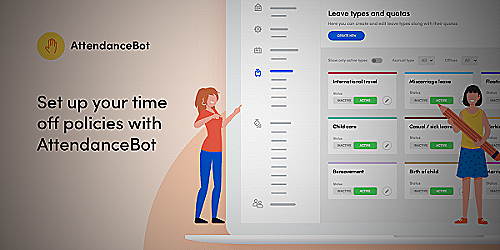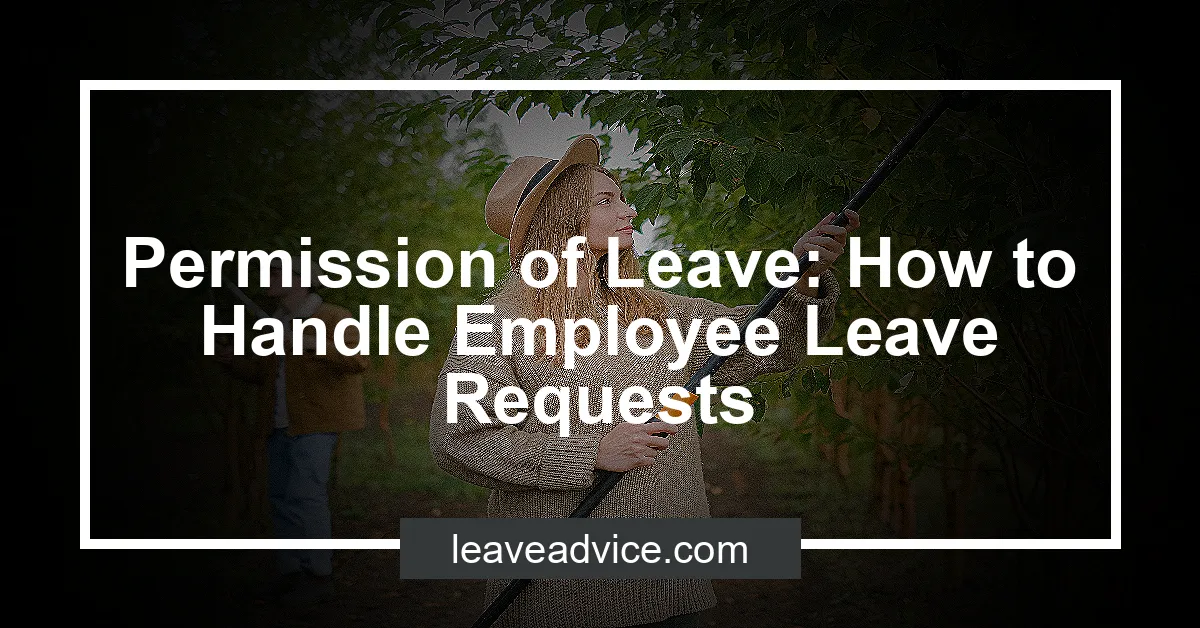Permission of Leave: How to Handle Employee Leave Requests
Permission of leave refers to the approval obtained by an employee from their employer to take a specific period of time off from work. It is an important aspect of employment as it provides employees with the necessary time off to attend to personal or medical issues.
However, this is not a benefit that employees can abuse, and its usage is conditional and must be properly managed to ensure productivity and business continuity. In this blog post, the concept of permission of leave is explored in-depth, with arguments and examples of why the right usage of leave is important for both employers and employees.
Are you tired of feeling awkward when you need to ask for time off? Check out this Youtube video: “How to ask permission for leave | Professional Communication” for helpful tips and advice on navigating this tricky situation.
If you want to know how to request a leave of absence in a professional and respectful way, this video is for you. Don’t miss out on valuable insights and strategies – watch it now!
Types of Employee Leave
When it comes to taking time off work, employees are typically given a few different options. Some of the most common types of employee leave include:
- Sick leave: This type of leave is typically offered for employees who are ill or injured and need to take time off work to recover.
- Casual leave: This type of leave is often used for things like personal appointments or to handle unexpected events that arise.
- Public holiday: Depending on where an employee lives and works, they may be entitled to paid time off on certain public holidays throughout the year.
- Religious holidays: Similarly, some employers may offer paid leave for important religious holidays that are important to their employees.
- Maternity leave: Women who are expecting a child are often granted a certain amount of paid maternity leave to give them time to recover and care for their newborn.
- Paternity leave: Some companies also offer paid leave for new fathers, allowing them to take time to bond with their new child.
- Bereavement leave: When an employee experiences a death in the family, they may be entitled to a few days of paid time off to grieve and attend the funeral.
Keep in mind that each of these types of leave may have different requirements or rules that employees must follow in order to be granted permission to take time off. In some cases, employees may need to provide documentation or seek approval from their employer in advance.

Employer’s Responsibility and Rights
When it comes to employee leaves, employers have certain responsibilities as well as rights especially when an employee requests for permission of leave.
Legal Implications of Employee Leave
Before an employer grants permission of leave, they need to consider the legalities involved such as the laws on employee leave, insurance policies, covered employees, and leaves that require employer’s permission. It is important for employers to understand their obligations and protect themselves from legal implications.
For instance, the Family and Medical Leave Act (FMLA) in the US requires employers to grant eligible employees unpaid leave for serious medical conditions or when they need to take care of a family member with a serious medical condition.
Handling Employee Leave Requests
It is crucial for an employer to have a clear procedure in place when an employee requests for leave to ensure fairness and consistency. A step-by-step guide on the request procedure, approval procedure, documentation procedure, and employer’s response timing should be established.
This helps in determining who approves leave and under what circumstances. It also helps in maintaining accurate records and tracking employee leave.
Employers also have the right to deny leave requests if they are not submitted in time or if they are not covered by federal or state laws.
Employee’s Responsibility and Rights
When an employee needs to take leave, it is important to understand their responsibilities and rights. In general, leave is a conditional right rather than a benefit.
There are different types of leave an employee may be entitled to, such as sick leave, casual leave, public holidays, religious holidays, maternity leave, paternity leave, and bereavement leave. Employees may also be entitled to additional leave under federal or state law or through voluntary leave offered by employers.
Request for Leave Procedure
When requesting leave, an employee should follow the proper procedure. This may include explaining the need for the leave and the type of leave needed, the length of the leave, the timing of the leave, and how to submit the request.
For example, if an employee needs to take maternity leave, they should inform their employer of their expected due date and the length of time they plan to take off. Employers may require employees to submit a formal request for leave using a specific form or process.
Approval Process and Timeline
After submitting a request for leave, an employee should be informed of the approval process and timeline. This may include how long it will take for their request to be processed, how they can check the status of their request, and what to do if their request is denied.
For example, an employer may require the employee to provide medical documentation to support a request for sick leave or maternity leave. Employers should provide clear guidelines and procedures for employees to follow when requesting leave.
Options for Employers and Employees
When it comes to taking a leave from work, employees need to request permission of leave from their employers. There are various forms of leave that employees might request, such as sick leave, casual leave, public holiday, religious holidays, maternity leave, paternity leave, and bereavement leave.
In some cases, employees may be entitled to leave by federal or state law. Employers can also supplement their legal obligations with voluntary leave.
Sick Leave and Casual Leave
Sick leave and casual leave are two forms of leave that many employees are entitled to. According to the United States Department of Labor, employees covered by the Family and Medical Leave Act (FMLA) may take up to 12 weeks of unpaid leave for a serious health condition or to care for a family member with a serious health condition.
Employers can also provide paid sick leave to their employees. In addition, employers can offer casual leave which is usually taken for personal reasons such as attending to an urgent matter.
Public Holidays, Religious Holidays, and Bereavement Leave
Public holidays, religious holidays, and bereavement leave are some of the most common forms of leave that most employees are entitled to. According to the United States Department of Labor, one of the eight Federal holidays is New Year’s Day.
Employers may also provide employees with paid time off for religious holidays. In addition, employees are entitled to bereavement leave to attend the funeral of an immediate family member such as a parent, spouse, or child.
Foreseeable leave should be requested at least two weeks prior to the start of the leave, or as soon as practicable. If the leave is unforeseeable, the leave request should be made as soon as practicable.
Flexible Schedule and Remote Work
Employers may also provide options for flexible schedules and remote work. A flexible schedule means that the employee still works the regular hours but has the freedom to choose when and where they work.
This can be beneficial to employees who need to take care of their family or other personal matters. Remote work, on the other hand, means that the employee works from home.
This can be beneficial to employees who are unable to come to the office due to medical reasons or other personal circumstances. Employers need to provide policies for remote work to ensure that work is being done properly and efficiently.
Stock options allow employees to buy a piece of the company at a discounted price in exchange for their dedication and commitment. This can be a great way to incentivize employees to stay with the company for a longer period of time and to help them feel valued by the company.
Frequently Asked Questions
Can an Employer Deny or Delay an Employee's Leave Request?
Can an Employee get Fired for Requesting Leave?
How Long Can an Employee be on Leave?
Conclusion
Permission of leave is an important aspect that relates to both employers and employees. Employees have conditional rights and can request leave in cases such as sick leave, casual leave, public holidays, religious holidays, maternity leave, and more.
Employers can meet their obligations towards their employees by providing voluntary leave. Planning for foreseeable leave is crucial and should be requested at least two weeks prior to the start of the leave.
Employees may also be entitled to leave by federal or state law, with the Family and Medical Leave Act (FMLA) providing eligible employees up to 12 workweeks of unpaid leave. Employers can also provide stock options as a way to retain employees.
Understanding the ins-and-outs of permission of leave and taking proactive steps can ensure a healthy and happy workplace for all.

